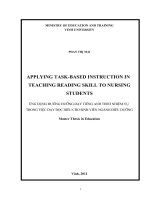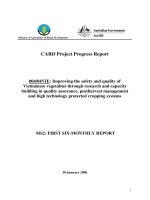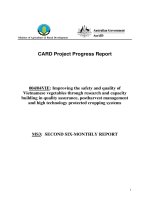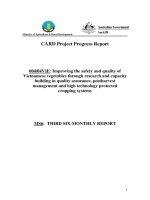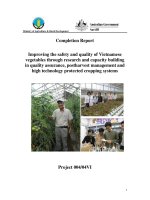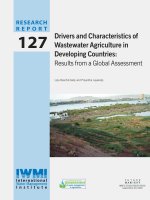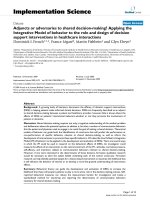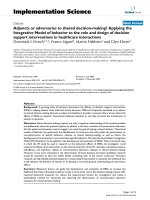Building and applying interactive screen experiment in developing positiveness, self-reliance and creativity of students in teaching mechanical motion of particle (Physics 10)
Bạn đang xem bản rút gọn của tài liệu. Xem và tải ngay bản đầy đủ của tài liệu tại đây (599.01 KB, 25 trang )
1
INTRODUCTION
1. Reason for choosing the topic
Resolution No. 29 by the Central Communist Party No. 8, term XI on basic and
comprehensive innovation on education and training to meet the demands for the course of
industrialization and modernization in the context of present international integration and
confirmed “it is necessary to transform the educational process from focusing on knowledge
instillation to emphasizing the forming, capacity building and quality of the learners”, and
emphasizes comprehensive education, developing creativity, selfstudy, practical ability and
skills, applying the knowledge into practice. Therefore, one of the teaching targets of physics
at schools in “to develop scientific thinking of students, activeness, selfstudy in constructing
and applying the knowledge, to creatively apply to solve the problems in studying and
practice”. At the same time, base on the characteristics of physics in schools :”Physics in
schools is mainly experiments in which there is a flexible combination between observation,
experiments and theoretical inference to achieve the agreement of theory and practice”, we
realized that the applying with the method of teaching discovery and problem solving in way
of experimental and theoretical reasoning with checking experiemental results is effective in
developing the active awareness, selfstudy and creativity of students in studying physics.
The analysis of content characteristics, teaching and studying status of physics in some
high schools in Thai Nguyen, Tuyen Quang, Quang Ninh, Phu Tho province, etc….showed
that the using of experiments with the method of teaching discovery and problem solvingin
teaching physics – especially teaching mechanical movement of material ooints with the
purpose to develop active aweareness, selfstudy and creativity of the students are not paid
attention to appropriately for many different reasons.
In comparing the objectives of training programs, knowledge contents and functions of using
experiments in teaching physics, effect of the method of with the method of teaching discovery
and problem solving, the status of teaching and studying physics, one of the methods is using
experiments in teaching of physic in the means of discovery and problem solving.
That is the reason why we chose the topic: “Building and applying interactive screen
experiment in developing positiveness, selfreliance and creativity of students in teaching
mechanical motion of particle (Physics 10)”
2. Research objectives
Building and applying interactive screen experiment in teaching and studying
mechanical movement of particle in Physic 10 to develop active awareness, selfstudy and
creativity of the students.
3. Objectives and scope of research
2
Knowledge contents and the method of teaching discovery and problem solving in
mechanical movement of material points in Physics 10
The construction of interactive screen experiment on mechanical movement of material points.
The designing and organization of active awareness for the students using interactive
screen experiment, specifically the interactive experiments on the screen have made some
knowledge contents in mechanical movement of material points (Physics 10).
4. Scientific hypothesis
If the interactive experiments on the screen on mechanical movement of material points
are successfully carried out but still ensure the functions of a physical experiments and can be
used effectively in the method of teaching discovery and problem solving, it is possible to
develop active awareness selfstudy and creativity of students in studying mechanical
movement of material points (Physics 10).
5. Reasearch tasks
The theoretical research on the forming of teaching mechanical movement of material points.
Reasearch on the teaching theory on the method of teaching discovery and problem
solving; from which apply the method of teaching discovery and problem solving in teaching
mechanical movement of material points.
The modern theoretical research on the organization of active awareness, selfstudy
and creativity of the students;
Theoretical research on physical experiments using and combining interactive
experiments on the screen and traditional experiments in developing active awareness, sel
study and creativity for the students..
Inspection on the status of experiments, teaching status of mechanical movement in
material points in Physic 10 program; from which identifying the difficulties which the
teachers face during organization of the active awareness, selfstudy and creativity activities
for the students.
Researching and constructing interative experiments on the screen on mechanical
movement of material points so that it is possible to apply the interative experiments to meet
the demands of experiment equipment in these aspects: science, technology, pedagogy,
economics, and aesthetics.
Recommendations for the solution for using interactive experiments on the screen have
included and combined the practical experiments in organizing active awareness, selfstudy and
creativity activities for the students in teaching mechanical movement of material points.
Drafting the teaching process for the types of mechanical movement of material points with
the method of teaching discovery and problem solving, in which use the organized digital
2
3
experiments or combine the digital experiments and the available traditional experiments in a way
to develop the active awareness, selfstudy and creativity of the students.
Pedagogical experiments were drafted to assess the feability of teaching process and
the constructed experiments in order to supplement, complete the teaching process. The
constructed experiments to develop active awareness, selfstudy and creativenss of the
students in studying mechanical movement of material points.
6. Research method
Theoretical research: doing research, analysis on the teaching theories, teaching
theories of the subjects to understand the teaching point of views, teaching methods and types
of teaching organization, experiment equipments, the using and combination of experiment
equipments to organize activities to develop active awareness, selfstudy and creatvenss of
the students; the program materials, textbooks, teacher’s books and the materials related to
experiment equipments regarding mechanical movement of material points in Physics 10;
materials about construction softwares on the computer, particularly Macromedia Flash.
Practical research: doing study on the teaching status of mechanical movement of
material points (Physics 10) by class observations, direct discussions with teachers and
students, survey results of teachers and students’ view points.
Pedagigical experiment method: is being conducted in experimental classes according
to the drafted teaching process and applied the method of teaching discovery and problem
solving; in order to analyze and assess active awareness, selfstudy and creativity of the
students during and after pedagogical experiment process; give the tests to students in the two
groups of experiment and compare the results.
Mathematical statistic method: using mathematical statistics to process the data of
experiment and assess the results of experiments.
7. The new points of the research
Specify the stages of forming knowledge as mechanical movement of material points
with the method of teaching discovery and problem solving.
Constructing 05 interactive experiments on the screen which maintain the functions of a
physical experiment can help to organize the activities to develop active awareness, selfstudy and
creativity in teaching mechanical movement of material points in Physics 10 program.
Proposing 06 measures of using constructed experiments and using or combination
with the traditional experiments in developing active awareness, selfstudy and creativity of
the students in teaching mechanical movement of material points.
Drafting 05 teaching process for mechanical movement of material points (physics 10)
in which using constructed experiments or combine using of traditional experiments ,
applying the method of teaching discovery and problem solving to develop active awareness,
selfstudy and creativity of the students.
4
Pedagogical experiments and assessment of the feasibility of teaching process, using
of constructed experiments, combined using of available experiment equipments in teaching
mechanical movement of material points (physics 10) to develop active awareness, selfstudy
and creativity of the students.
Chapter 1: OVERVIEW OF RESEARCH POINTS
In this chapter, we would like to give the overview on the genearal consctruction and
using of experiemnts, especially digital experiements in teaching mechanical movement of
material points to develop active awareness, selfstudy and creativity of the students. Through
studying the scientific reports, doctorate thesis or postgraduate thesis concerning this topics,
we realize that:
The construction and using of experiments in teaching mechanical movement of
material points is a topic of interest for Vietnamese authors as well as international authors
and there were many optimistic results. However, there is still no research which includes
principles, combined using measures of digital experiments and other experimentsin teaching
mechanical movement of material points to develop active awareness, selfstudy and
creativity of the students.
From the above analysis, we saw the focusing points of reasearch are as follows:
Doing research interactive screen experiments on mechanical movement of material points
(Physics 10) which ensure scientific criteria, pedagygy, technology, economics and aethestics.
Proposing the measures of using constructed interactive screen experiments and the
combined using measures of avalable experiments in developing active awareness, selfstudy
and creativity of the students.
Applying the theory on the method of teaching discovery and problem solving to build
the teaching process for mechanical movement of material points (Physics 10), in which
using the constructed interactive experiments on the screen and combined available
experiments to develop active awareness, selfstudy and creativity of the students.
4
5
Chapter 2: THE THEORETICAL FUNDAMENTAL AND PRACTICE OF
CONSTRUCTING AND USING INTERACTIVE SCREEN EXPERIMENTS IN
TEACHING MECHANICAL MOVEMENT OF MATERIAL POINT TO DEVELOP
ACTIVE AWARENESS, SELFSTUDY AND CREATIVITY OF THE STUDENTS.
In this chapter, we mentioned the theoretical and practicle problems regarding the
research topic such as: developing active awareness, the common activities in the physical
awareness of the students; the stages of forming knowledge of mechanical movement of
material points; applying the method of teaching discovery and problem solving in teaching
mechanical movement of material points and organizing activities to promote active
awareness, selfstudy and creativity of the students in high schools; physical experiments and
using physical experiments in promoting active awareness, selfstudy and creativity of the
students ; and the status of using physical experiments in teaching physics at high schools.
2.1. Develop physical awareness of the students
The development of physical awareness of high school students also follow the
development theory of Jean Piaget (1896 1980) and Lev Vygotski (1896 1934). At present,
the two theories are considered the most important achievements of development psychology
and be the foundation to build the new teaching methods and strategies.
2.2. Teaching about mechanical movement of material point
Typically, in the teaching of physics in high schools, the study of a phenomenon of
mechanical movement is usually done in the following order:
From the outward signs of any common movement, the concept of physical quantities
characterizing the motion as displacement, velocity, acceleration is formed.
Then, depending on the specific characteristics of physical quantities characterizing
the motion that led to the study of each particular motion.
The study of each type of quality mechanical movement points after having the
concepts specific to the most general motion is consistent with the structure of the program in
ordinary physics today, matching the level of the students and matching time periods. When
studying each kind of quality mechanical movement point, students should introduce the
concept of motion (defined motions), conditions occur motion (with or without content,
depending on the type of transfer concrete), understanding the relationship between the
quantities characterizing the motion (the laws of motion). That means, teaching knowledge of
quality mechanical movement of two teaching points include the following:
6
The phenomenon of a mechanical movement of material point: defining the
movement, the conditions for the movement (whether or not this content, depending on the
particular type of movement)
The law of motion / the relationship between the quantities characterizing motion
2.3. Developping positiveness, selfreliance and creativity of students in teaching physics
under the method of discovery and problem solving
2.3.1. The method of discovery and problem solving
Teaching discovery and problem solving, in the most common format, (according to V.
Okon) is all the activities such as organizing problematic situations, defining problems (help
the students to do this task themselves), provide them with necessary things to solve the
problems, check the solutions and systemization and reinforcing the acquired knowledge.
2.3.2. Develop active awareness of students in studying physics under the method of
discovery and problem solving
In applying the view points on development of Jean Piaget and Lev Vygosky which is
attached to the method of teaching discovery and problem solving, we would like to propose
some of the measures to develop active awareness of students in styding physics as follows:
Use study cases (which contain the awareness conflicts and research problesm) creating
the imbalance (in terms of awareness) of the student causing conflicts the students
have motivation to solve the problesm – the basis to sovle the research problems.
Control, direct the students to solve the problems in awareness (solve the research
problems) by taking the students to “close development zone”, stimulate the students to solve
the problems to supass the “close development zone”. As the result, the students must be
active to think of the solutions to the problems, realizing problem solving and creating the
“balance” and drawing conclusions.
In order to develop the active awareness of the students in thinking of the solutions and
solving the problems, it is necessary to use teaching aids, eperiement equipment to to
stimulate and maintain the interest of students or the teachers can request the students to
propose solutions, carry out experiments or improve the experiments. …
2.3.3. Develop selfstudy of students in studying physics under the method of discovery
and problem solving
On the basis of the two theories by Jean Piaget and Lev Vygosky on development of
awareness, applicable for the method of teaching discovery and problem solving, we would
ike to propose some measures to develop selfstudy of students in studying physics as
6
7
follows: Identify the “boundary” of “close development zone” – which according to
Vygosky, is a “current level which is determined by the independence to solve the problem
(task)” of the students to define the tasks which the students can do themselves to achieve the
“balance” in terms of awareness. The tasks are specified as follows:
+Noticing the awareness conflicts, the issues for research in cases which include the issues.
+ Identifying the necessary knowledge and skills to construct the measures to solve the
problems in theoretical reasoning method.
+ Conducting the built measures according to the theoretical reasoning method to solve
the problems.
+ Conducting experiments to check the hypothesis (consequences) or check the results
from theoretical reasoning to draw the results.
+ Presenting and defending the results.
+ Finding out the application scope of the knowledge and apply the knowledge in the
concrete cases.
+ Make connections of the knowledge with practice.
It is possible to achieve the abovementioned results. One of the solutions is to use
experiments in teaching and studying physics with the method of teaching discovery and
problem solving.
2.3.4. Develop the creativity of students in teaching physics under the method of
discovery and problem solving
In application of the theories on awareness development of Pieget and Vygosky in terms of
teaching discovery and problem solving, the teacher needs to identify the “close development
zone” and its “upper boundary”, which according to Vygosky, is the “nearest level the student can
reach with the help of their friends and adulst when solving the problems” to help the students
develop their creativity and from that, the teachers can direct the students in solving the problems
in a creative way through the following specific measures:
Practice making hypothesis. Making hypothesis plays a very important role in
scientific creativity. Construction of hypothesis relies mostly on intuitions, the diverse
experience and profound knowledge of each field. Making hypotheisis cannot be
spontaneous but must always have a base even if it is not really certain.
Practicing making experiments to check the found results and make theoretical
reasoning or check the accuracy of the hypothesis. When we apply the method of teaching
discovery and problem solving, helping the students to practice making experiments to check
the found results and make theoretical reasoning or check the accuracy of the hypothesis is
8
one of the most important measures to develop the creativity of the students.
Practicing application of knowledge and new skills to explain and forsee new
physical phenomena.
2.4. Applying the method of discovery and problem solving in teaching in teaching
mechanical movement of material points
Teaching mechanical movement of material point include teaching two following:
The concept of mechanical movement of material point (defining the movement, the
conditions for movement).
The law of motion / the relationship between the quantities characterizing motion
For each knol, here we apply the method of discovery and problem solving to to
concretize the steps in the process of forming knowledge of mechanical movement of
material point
Table 2.1: Specific steps in forming the concept of mechanical movement of material
point using method of teaching discovery and problem solving
The stages in teaching
Certain steps of the stages
discovery and problem
solving
1. Leading to the
resoved issues
Describe the processes, phenomena (which are the
movements) of the same catagories
Declare the researched issues relating to the common signs, the
2. Declaring issues
3. Solving issues
nature of the motion was presented
How to do the experiments, observe the movements and
analyze the movements to discover the natural signs which are
common for those movements
4. Conclusions
Drawing conclusions for all the common natural signs of the
movements.
8
9
Bring a new definition for the movements which have the
same sigs and make definitions for the movements and
conclude the conditions to have these movements (this
content may be repported or not depending on the type of
movement.
Application and proposing the next issue for research
5. Application
Table 2.2: Specific steps in forming the rules / relationships of quantities
characterizing motion of mechanical movement of material point
using method of teaching discovery and problem solving
The stages in teaching
discovery and
problem solving
1. Leading to the
resoved issues
2. Declaring issues
3. Solving issues
Certain steps of the stages
Describe / present situations concerning the characteristics and
laws of the phenomenon (which are the movements) to study
Declare the researched issues relating to the laws of motion;
the relationships of quantities characterizing motion of
mechanical movement
Theoretical approach
Experimental approach
10
Deduce to find out the
results (answers to research
questions) about: laws of
motion; the relationships of
quantities characterizing
motion of mechanical
movement
Determine the contents that
can be tested by
experiments
Propose hypotheses for
laws of motion; the
relationships of quantities
characterizing motion of
mechanical movement
Conduct experiments to test
Conduct experiments to test
Determine the contents
(hypotheses or the
consequences to be drawn
from the hypothesis) that
can be tested by
experiments
Design plan experiments Design plan experiments to
to test
test
4. Conclusions
Draw the conclusions for the laws of movement, the
relationship/ qualitative expressions (if any) which represents
(unify, specify)/ the natural characteristics of the movements.
5. Application
Explanation of exercises involving movement were studied
Experimental study of the motion of the same kind in real
Applying raises new research issues
…
Note: The construction/forming of the characteristics of movements according to the
teaching theory of physical knowledge as written in textbooks, coursebooks about physical
teaching theories of the author Nguyen Duc Tham, Pham Huu Tong, Nguyen Ngoc Hung...
10
11
2.5. Interactive screen experiments and application of interactive screen experiments in
teaching physics to promote actuve awareness, selfstudy and creativity for the
students.
2.5.1. Physical experiments
The physical experiments are defined as the intentional and systematic interactions of
human to the subjects of reality. Through analysis and the conditions in which there are
interactions and the results of the interactions provide us with new knowledge.
There are many ways to distinguish physical experiments. Basing on different criteria,
there are different experiments.
Basing on conducting laboratory experiments, there are two kinds of physical
experiments: performing experiments of teachers and practicing experiments of students.
Basing on the technology in which the experiment equipments count on that activity,
there are two kinds of physical experiments: traditional eperiments and technical digital
experiments.
+ Traditional experiments are the experiments whose activities do not base on digital
technology. The subject of research for traditional experiments is the process, real physical
phenomena which are presented originally. Researchers will make direct impacts on the
subjects of research and cause changes to the subjects and receive information about the
subjects. This activity is made in the experimental environment (not through the computers)
with the use of tools and equipments to collect the data directly from those refllecting the
process and characteristics of the researched phenomena.
+ Digital experiments are the experiments in which our activities or a part of our
activities base on ditigal technology. In a digital experiments, the subjects (process,
phenomena) are true. However, the information about the process, physical phenomena was
decoded into digital date and processed by the digital equipment through computers.
Base on the signs of interactions with these subjects, digital experiments are
categorized into two types:
+ Experiments to connect the computers: are experiments in which the leaners interact
directly with the researched subjects.
+ The interactive experiments on the screen: are the digital experiments in which the
learners interact indirectly through the mouse, keyboards or compters’ screen..
The subjects or research in digital experiments on the screen are the phenomena and
physical processes which are recorded (video tape or camera) under original form and
instered to the computers using computer softwares through which the learners can interact
with subjects of research on the screen, making changes to the subjects of research in their
own purposes or orders to achieve equivalent results.
Thus, it can be understood that digital experiments on the screen are conducted in an
environment which is a teaching software on the computers in which the phenomena and
physical processes were recorded and insrted into the softwares to process information
relating to the charateristics of the phenomena and processes.
12
2.5.2. The interactive screen experiment in teaching physics
Research subjects in interactive screen experiment are real physical processes or
phenomena that are recorded (video capture or capture) as root and put into the
computer, using computer software tools, then pupils can learn to manipulate on
screen objects to interact with researchers, alters the object of study according to the
purpose, order your own research and get the corresponding results. Interactive
experiments on screen with features like a physics experiments such as the conditions
of the experiment were selected and are set intentionally so through experiments, can
answer the question posed, may test the hypothesis or the consequences deduced from
the theory; the conditions of the experiment can be transformed so that we can study
the dependence between two quantities while other variables held constant; the
conditions of the experiment are contained, controlled properly as intended by the use
of laboratory equipment with precision the extent necessary; may observe the change
of certain quantities due to the change of other quantities; can repeat the experiment.
Thus, with reference to the definition and characteristics of physics experiments,
interactive experiments on the screen can be confirmed as a physics experiment.
2.5.3. The functions of interative experiments on the screen in teaching physics
Subjects of study (the processes or physical phenomena) which are presented in front
of the students are true (under original form or origincally recorded pictures).
Supports in making research hypothesis
Collecting information regarding the subjects of study.
Presenting different information collected under various forms.
Analyxing, processing information for different purposes.
Helping the students to check scientific hypothesis (or the consequences of the
hypothesis)
Helping the students to conduct experiments and physical observations at home
(revew, reinforcing and technical preparation, practice)
In comparison to traditional experiments, digital experiments have certain strengths and
weaknesses. Therefore, during the teaching process, in order to optimize active awareness,
selfstudy and creativity of the students, the teachers must combine using of different
experiments, through which helping to develop the strengths of each kind of experiments.
2.5.4. Combined using of interactive experiments on the screen and traditional
experiments in teaching mechanical movement of material points to develop
active awareness, selfstudy and creativity of the students.
The combined using of different kinds of experiments in teaching physics must ensure
the following rules:
Only use the interative experiments on the screen (digital experiments_ when the
traditional experiments do not help the students to fully understand the knowledge or when
they are not being assited in organizing activities to develop active awareness, selfstudy and
creativity of the students.
It is possible to use interative experiments on the screen and combine using of
traditional experiments at different stages of the teaching process, etc…. However, it is
12
13
important to pay attention to the strengths and weaknesses of each experiment, specific
functions and appropriateness of the experiments in teaching purposes.
Combine the using of the two types of experiments (digital experiments on the screen
and traditional experiments0 with the system of intellectualpractical activities of the students
during the process of making experiments such as identifying the experiments (checking
hyoothesis, results form theoretical reasoning, measuring the physical qualitative, etc..)
designing the solutions for experiments, choosing and arranging the tools, making plans for
the experiments, collecting, presenting and processing the data) through which to stimulate
the students in their study.
It is necessary to combine the using of two types of experiments to meet the
requirements for practicing experiment (experimental skills) and creat the conditions for the
students to participate in building the knowledge in a systematic manner. (through the
functions which present the physical experiments during knowledge construction).
Belows are some of the using methods of digital experiments on the screen or combined
using of digital experiments and traditional experiments in teaching mechanical movement of
material points with the method of teaching discovery and problem solving to develop active
awareness, selfstudy and creativity of the students.
Combine using of traditional experiments and digital experiments at the stage which
appears issue for research.
Using interactive experiment on the screen to support hypothesis
Combine using of digital interative experiments and traditional experiments to conduct
the proposed experimental solutions (in the step of cheking hypothesis or checing the
withdrawn results from the hypothesis).
Using digital experiments on the screen in the stage of reinforcing and applying the
knowledge.
Using digital experiments on the screen to support the reviewing process, preparation
before class or practice of traditional experiments in the labs (students conduct experiments
and observe the results at home)
Use traditional experiments and digital experiments on the screen to support the
process of checking, assessment or knowledge and skills of students (designing skills)
2.6. The status of using experiments in teaching physics at high schools
With the purpose of studying the status of teaching knowledge and the types of
mechanical movement or material points, we have made practical investigation in the status
of teaching and studyting of students and teachers in some high schools to find out the
information regarding: the status of experimental equipments in high schools; the study
methods of students and the common difficulties when the students study mechanical
movement of material points; teaching methods and the using frequency of experiments in
teaching mechanical movement of material points.
On the basis of analyzing the survey results, we would like to give some assumptions on
the equivalent reasons of the status, from which we would like to propose a solution to
address the limitation and apply the teaching targets in the thesis, which are:
14
Doing research and build the digital experiments on the screen on the content of
mechanical movement of material points so that the digital experiments on the screen can
meet the requirements of an experimental equipment in the aspects: technology, science,
economic, aesthetics.
Proposing the measures for using constructed measures and combine using of other
available experiments in organizing activities to develop active awareness, selfstudy and
creativity of the students.
Drafting the teaching process for mechanical movement of material points using the
method of teaching discovery and problem solving which use digital experiments on the
screen or combine using of digital experiments on the screen and traditional experiments to
develop active awareness, selfstudy and creativity of the students.
CHAPTER 3: BUILDING AND APPLYING INTERACTIVE
EXPERIMENTS ON THE SCREEN IN TEACHING SOME
KNOWLEDGE ABOUT MECHANICAL MOTION OF PARTICLE
3.1. Building and applying interactive experiments on the screen in teaching some
knowledge about mechanical motion of particle
From the requirement of experiments used in the process of teaching about mechanical
motion of particle styled detective teaching and issue settlement in order to develop positive
cognitive performance, selfreliance and creativity of student, we had studied and built a
teaching sortware that we can conduct interactive experimentss on screen for various types of
mechanical motion of particle in a plane, specifically, with in scope of study of subject,
interactive experimentss on screen that software can be performed including: Constant
motion; Uniform variable motion; Freefall motion; Rotary motion (nonuniform and uniform)
and Motion of thrown object
Here, we present some images of interactive experiments on the screen about the object
thrown which was cut from the computer screen:
Interface of interactive experiments in research onscreen motion of objects thrown
Mark the position of the objects at the time of equidistant
Perform data collection and graphing coordinates time in two acute Ox and Oy
perpendicular
14
15
Figure 3.10a, b: Choose size and conduct standardized measurements to gather data
coordinates x and y in t
Figure 3.10c: Experimental plot (y, x), this graph coincides with graph fit standard functiony
= ax2 + bx+c (corresponding to specific values of a, b and c), witness prediction proved
orbital motion of objects thrown as parabolic form is correct.
Implement and measure the throw angle α and ramp ΔSo that point motion pharmaceutical
substances in very small time period Δt (to calculate the velocity throws vo)
\
Figure 3.11: Measuring α Figure 3.12: Measuring ΔSo
Drawing the graph (x, t), (y, t), (x, y), (vx, t), (vy, t), (v, t) and fit the standard function
16
Thus, with the support of interactive experiments on the screen, they can be based on the
graph drawing is to make scientific predictions and graphs using standard function fit with
experimental graph to check predictions (hypotheses science) has proposed or examine the
consequences drawn from the scientific hypothesis.
The experimental data collected learners and results of data processing will be output to
the screen so students and teachers can test and evaluation.
Experiments with interactive onscreen, teachers can use in the process of teaching the
knowledge of all kinds of quality mechanical movement can point teaching style applied to
detect and resolve problems in order to develop activities positive cognitive, selfreliance and
creativity of students
3.2. Designing teaching process for some knowledge about mechanical motion of particle
with interactive experiments on screen
By designed interactive experiments on screen combined with available traditional
experimentss, we have designed 05 teaching processes styled detective teaching and issue
settlement in order to develop positive cognitive, selfreliance and creativity of the students,
including: Constant motion; Uniform variable motion; Freefall motion; Rotary motion
(nonuniform and uniform); Motion of thrown object
Here, we present an example of logical diagram of scientific progress building knowledge
motion of thrown object:
16
17
18
18
19
CHAPTER 4: PEDAGOGIC PRACTICE
4.1. Purpose, object and assessment process of pedagogic practice
4.1.1. Purpose of pedagogic practice
Pegagogic practice in high school is to test the correctness of theory through:
Assessing the feasibility and effectiveness of teaching process that is drafted
(including experimentss on screen combined with traditional experimentss) in the
development of positive, selfreliant and creative energy of students.
Proposing orientation to adjust teaching process and complete interactive
experiments on screen as built based on that basis.
4.1.2. Object of pedagogic practice
Object of pedagogic practice is 10grade student in high school in teaching process of
knowledge about mechanical motion of particle.
4.1.3. Assessment process for positive, selfreliance and creative capacity of students
4.1.3.1. Assessment process for positiveness, selfreliance and creative capacity of students
in practice lesson
Step 1: Determining assessment purposes.
Purpose of assessment: positiveness, selfreliance and creative capacity of students in
practice lesson
Step 2: Determining the assessment criteria for each assessment purposes.
+ Criteria for positiveness
+ Criteria for selfreliance
+ Criteria for creative capacity
20
Step 3: Determining the level to each assessment criteria
Step 4: Building Rubrics
Step 5: Determining how to collect information
Step 6: Determining assessment method
Step 7: Peforming assessment
4.1.3.2. Assessment process after practice lesson
Step 1: Determining assessment purposes.
Purpose of assessment: Learning achievements of students through the test.
Step 2: Determining the level of awareness and performance corresponding to each level.
Step 3: Build matrix to test.
Step 4: How to collect information.
Step 5: Method of assessment
4.1.4. Time, location and preparation for pedagogic practice
Pedagogic practice is performed in two academic years including 2012 – 2013
and 2013 – 2014.
Pedagogic practice is performed in 02 high schools including Viet Bac
Highland High school and Luong Ngoc Quyen High school.
The selection of experiments and reference groups is guaranteed under the equal
principle among elements including quantity, ethnic composition, proportion of male/ female,
behavior, study capacity.
4.2. Analyzing and assessing the results of pedagogic practice
After the first pedagogic practice, we adjusted interactive experiments on the screen as
designed, simultaneously adjusted teaching process as appropriate. After adjusting and
completing interactive experiments on screen and teaching process about various types of
particle motion, we shall do pedagogic practice for the second time, collect data and analyze
the result as follows:
From the results of positiveness, selfreliance, and creative capacity of student during
pedagogic practice, we found the positiveness, selfreliance and creative capacity of student
in process of awareness for physical knowledge who have chance to develop and develop
through each lesson:
+ In the first pedagogic practice lesson (knoledge of uniform variable motion) using
combination of interactive experiments on the screen and available traditional experiments in
teaching process that students have many chances to determine contents tested by
experiments, peform interactive experiments on screen to test content that traditional
experiments is impossible. In addition, organization of teaching process using pedagogic
practice to help student to save time in collecting and processing data, which student can
20
21
spend lot of time to develop their positiveness, selfreliance, and creative capacity in solving
other tasks of lesson.
+ For the second lesson, (knowledge of freefall motion), this is motion with straight
trajectory, therefore, student shall be easy to apply such knowledge that is learned from
previous lessons. Therefore, with the percentage of positiveness, selfreliance and creativity
of students, we found that the second pedagogic practice is more developed than the first one,
especially in the content of practice, proposed with experiments plan, review for conclusion.
+ For the third lesson (knowledge of rotary motion), this is a new motion, most of
student unknow real experimentss and interactive experiments on the screen, it can be studied
this motion, therefore, in the process of implementing this motion, students have encountered
with some difficulties, resulting the creativity of students without positive changes compared
with the second one. However, after being introduced and guided for using interactive
experiments on the screen to test, students are very positive, selfreliant in solving the next
task (implementing experiments, getting the results and conclusion), this is clearly reflected
by number of good and very good students in awarenes, comments the conclusions in the
third lesson compared with the second one.
+ For the fourth lesson (knowledge of thrown motion), because students are known as
type of interactive experiments on the screen that are experimentss used for studying various
types of straight or curved trajectory within plane, the ratio of students to participate in
positive perception, selfreliance and creativity to identify content that can test the content
tested by experiments, propose experiments plan, comment the result and draw out
conclusion with results better than previous lessons.
To assess whether cognitive performance through active, selfreliance and creativity,
students were aware of what knowledge, with level achieved? Yes, we have carried out
preparation and homework for students checked 25 minutes after each item pedagogical
practice. The results are as follows:
Table 4.13: The statistical parameters
Oder
1
2
3
Knowledges
Uniform variable motion
Groups
S
V (%)
TN
6.75
1.29
19.1
ĐC
5.96
1.01
16.9
TN
6.92
1.1
15.9
ĐC
6.1
1.13
18.5
Nonuniform variable rotary TN
motion
ĐC
6.98
1.11
15.9
5.98
1.12
Freefall motion
18.7
22
7.22
1.09
15.1
ĐC
6.08
Test results of pedagogical experiment by Student t test.
1.1
18.1
4
TN
Motion of thrown object
Using student t test to examine the effectiveness of pedagogical experiment, we have
Table 4.14
Table 4:14: The value of the quantity ttest
Degrees
Knowledges
Comparison
of
and
freedom
Uniform variable motion
Freefall motion
Nonuniform
variable
rotary motion
Motion of thrown object
40
2.28
1.68
40
2.5
1.68
40
2.51
1.68
40
2.57
1.68
In all the tests, while the accreditation of one side are the results obtained
experimental results prove effective pedagogical impact on student quality markedly.
Testing the hypothesis E0:
Inspecting the variance of the experimental class group and the control group with
theory classes E0: "The difference between group variance in the experimental class and the
control class group was not significant", we have Table 4.15
Table 4.15: Table comparing the quantity F and F
Degrees of
Knowledges
Comparison
freedom
and
Uniform variable motion
40
40
1,0
1.69
Freefall motion
40
40
1.63
1.69
Nonuniform variable rotary motion
40
40
0.98
1.69
Motion of thrown object
40
40
0.99
1.69
22
23
Critical value Fα find application in distribution panels F α = 0.05 level and with the
FTN = 40 degrees of freedom; FDC = 40 is 1.69, in all four cases have proved E 0 accepted
hypothesis ie the difference between group variance in the experimental class and the control
class group is not significant.
Test the hypothesis H0:
To compare the results of experiments, we tested the hypothesis that H 0: "The difference
between the average score in two samples is not significant with the same variance." With the
level of significance, Student survey distribution boards with degree of freedom is N TN + 2 =
78 NDC have critical levels tα = 2.0
Test results are shown in the following table 2.16:
Table 4:16: Table comparing the quantity t and tα
Knowledges
Degrees of
Comparison
freedom
and
Uniform variable motion
Freefall motion
Nonuniform variable
rotary motion
Motion of thrown object
78
2.12
2.0
78
2.19
2.0
78
2.68
2.0
78
3.05
2.0
In four tests, , means disprove the hypothesis of H 0, proved the difference between the
average score in two samples is shown meaningful results in practice groups higher than in
the comparision group in all tests.
From the analytical results of pedagogical practice, we have demonstrated:
The drafted teaching process is feasible, meets the performance of teaching
objectives.
This shows that interactive experiments on the screen as designed meets
functionalities of a physical experiments in organization of positiveness, selfreliance, and
creativity of the students in teaching knowledge about various type of motion of particle.
24
CONCLUSIONS AND RECOMMENDATIONS
For the purpose of study: “Building and applying digital experiments in teaching some
knowledge about machanical motion of particle in 10grade advanced physics to develop the
positiveness, selfreliance and creativity of students”, we have addressed the following
issues:
Studying theoretical basis on the way to create a physical phenomenon, applying the
knowledge to teach mechanical motion of particle.
Studying theoretical basis on the detective teaching and issue settlement which are
applied in teaching some knowledge of mechanical motion of particle.
Applying the theorectical basis for the detective teaching and issue settlement to
concretize the steps in the process of forming knowledge of quality mechanical movement
point.
Studying theorectical basis for physical experiments, the interactive experiments on the
screen, the role of experimentss in teaching physics, which resystematize principles combined
with interactive experiments on the screen and traditional experimentss in physics to develop
the positiveness, selfreliance and creativity of students.
Recommending 06 measures of applying and combining traditional experimentss and
interactive experimentss on the screen in organization of positiveness, selfreliance and
creativity in teaching knowledge of various types of mechanical motions of particle.
Actually investigation the teaching and some knowledge about mechanical motion of
particle (10grade physics in high school), identifying the difficulties in organizing the
positiveness, selfreliance, and creativity of students. Therefore, it is recommended solutions
for building and appling interactive experimentss on the screen in teaching knowledge on
mechanical motion of particle in order to develop positiveness, selfreliance and creativity of
students.
Building 05 interactive experiments on the screen to ensure the functionality of
physical experimentss, support process of organizing positiveness, selfreliance and creativity
in teaching some knowledge about various types of mechanical motions in 10grade advanced
physics, specifically constant motion, uniform variable motion, freefall motion, rotary
motions and motion of thrown object.
24
25
Applying 05 detective teaching and issue settlement for drafting the process of
teaching kinds of knowledge about mechanical motion of particle in 10grade advanced
physics, in which using built experiments or combining traditional experiments in order to
develop positiveness, selfreliance, and creativity of students.
The result of pedagogic practice confirms the feasibility of teaching process as drafted,
and confirms the effectiveness of interactive experiments on the screen in developing
positiveness, selfreliance and creativity of student, which is the result of pedagogic practice
confirms the correctness of scientific theory of the subject: “If the interactive experiments on
the screen on mechanical movement of material points are successfully and can be used
effectively in the method of teaching discovery and problem solving, it is possible to develop
active awareness selfstudy and creativity of students in studying mechanical movement of
material points (Physics 10).”
By implementation of the subject, we propose some following recommendations:
For using interactive experiments on the screen styled detective teaching and issue
settlement in the teaching process to develop positiveness, selfreliance, and creativity of
students, it shall be required following elements:
+ For teachers: It is required to understand and distinguish the stages of detective
teaching and issue settlement; trained to proficiently use software of interactive experiments
on the screen; changed the experiments method, assessment to students.
+ For students: It is required to have right vision about their learning, not passive in
getting knowledge that must be participated in the process of building knowledge with
relationship with practice.
+ For school: It is required to fully provide computer system, projectors to serve the
teaching and learning.
It is suggested to continuously study to complete interactive experiments on screen as built,
supplement interactive experimentss on screen corresponding with different physical knowledges
in high school.

